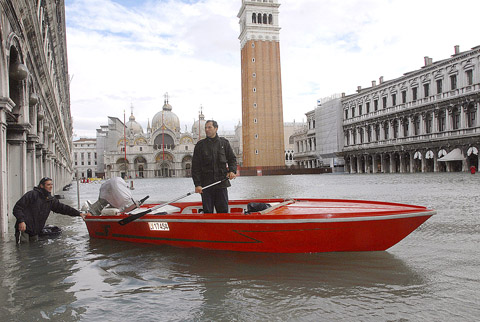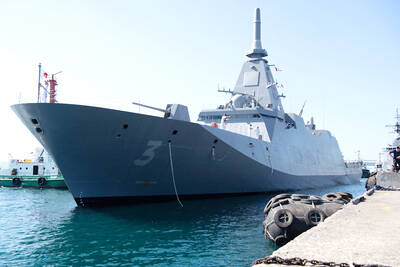Venice could use a bailout. The city built on water has too much of it.
Residents and tourists waded through knee-deep water on Monday as they navigated the city’s narrow streets and alleys and its historic St. Mark’s Square was inundated. Boxes of tourist merchandise floated inside the flooded shops around the square and even the city’s famed pigeons sought refuge on rooftops and windowsills.
One of the highest tides in its history brought Venice to a virtual halt, rekindling a debate over a plan to build moveable flood barriers in an effort to save the lagoon city from high tides.

PHOTO: AP
City officials said the tide peaked at 156cm, well past the 110cm flood mark, as strong winds pushed the sea into the city.
Alarms went off at 6:37am to alert citizens, but many residents were taken by surprise because authorities had initially not forecast such a high water level.
In St. Mark’s Square, one of the city’s lowest points, tourists tried to stay dry by hopping on cafe tables and chairs sticking out of the water. The water was so high that someone rowed a small speedboat across the wide square.
“It was quite an extraordinary experience,” said Michel Gorski, visiting from Brussels with his wife. “We got stuck in the hotel for half a day but we didn’t suffer. We were sorry for the restaurants and stores around, but there was no panic and everyone worked really hard to clean up quickly.”
Workers were unable to install the traditional raised wooden walkways used during flooding because the water rose so high the platforms would have floated away too.
It was the fourth-highest tide since 1872, when the city started keeping records. The last time Venice saw such high waters was in 1986, while the all-time record was 194cm in 1966.
That flood forced 3,000 people to evacuate and damaged many historic buildings, but largely spared the city’s art — which had long ago been removed to upper floors because of flooding by tides.
Giancarlo Galan, the conservative governor of the surrounding Veneto region, criticized Venice’s center-left administration for failing to prepare for the flood and for allegedly stonewalling a long-planned system of barriers that would rise from the seabed to ease the effect of high tides.
The US$5.5 billion project, called “Moses” after the Biblical figure who parted the Red Sea, has been under construction for years and is expected to be completed by 2011. The company building the barriers said that had the system been in place, the city would not have been flooded on Monday.

Nauru has started selling passports to fund climate action, but is so far struggling to attract new citizens to the low-lying, largely barren island in the Pacific Ocean. Nauru, one of the world’s smallest nations, has a novel plan to fund its fight against climate change by selling so-called “Golden Passports.” Selling for US$105,000 each, Nauru plans to drum up more than US$5 million in the first year of the “climate resilience citizenship” program. Almost six months after the scheme opened in February, Nauru has so far approved just six applications — covering two families and four individuals. Despite the slow start —

MOGAMI-CLASS FRIGATES: The deal is a ‘big step toward elevating national security cooperation with Australia, which is our special strategic partner,’ a Japanese official said Australia is to upgrade its navy with 11 Mogami-class frigates built by Japan’s Mitsubishi Heavy Industries, Australian Minister for Defence Richard Marles said yesterday. Billed as Japan’s biggest defense export deal since World War II, Australia is to pay US$6 billion over the next 10 years to acquire the fleet of stealth frigates. Australia is in the midst of a major military restructure, bolstering its navy with long-range firepower in an effort to deter China. It is striving to expand its fleet of major warships from 11 to 26 over the next decade. “This is clearly the biggest defense-industry agreement that has ever

DEADLY TASTE TEST: Erin Patterson tried to kill her estranged husband three times, police said in one of the major claims not heard during her initial trial Australia’s recently convicted mushroom murderer also tried to poison her husband with bolognese pasta and chicken korma curry, according to testimony aired yesterday after a suppression order lapsed. Home cook Erin Patterson was found guilty last month of murdering her husband’s parents and elderly aunt in 2023, lacing their beef Wellington lunch with lethal death cap mushrooms. A series of potentially damning allegations about Patterson’s behavior in the lead-up to the meal were withheld from the jury to give the mother-of-two a fair trial. Supreme Court Justice Christopher Beale yesterday rejected an application to keep these allegations secret. Patterson tried to kill her

MILITARY’S MAN: Myint Swe was diagnosed with neurological disorders and peripheral neuropathy disease, and had authorized another to perform his duties Myint Swe, who became Myanmar’s acting president under controversial circumstances after the military seized power from the elected government of Aung San Suu Kyi more than four years ago, died yesterday, the military said. He was 74. He died at a military hospital in the capital, Naypyidaw, in the morning, Myanmar’s military information office said in a statement. Myint Swe’s death came more than a year after he stopped carrying out his presidential duties after he was publicly reported to be ailing. His funeral is to be held at the state level, but the date had not been disclosed, a separate statement from the